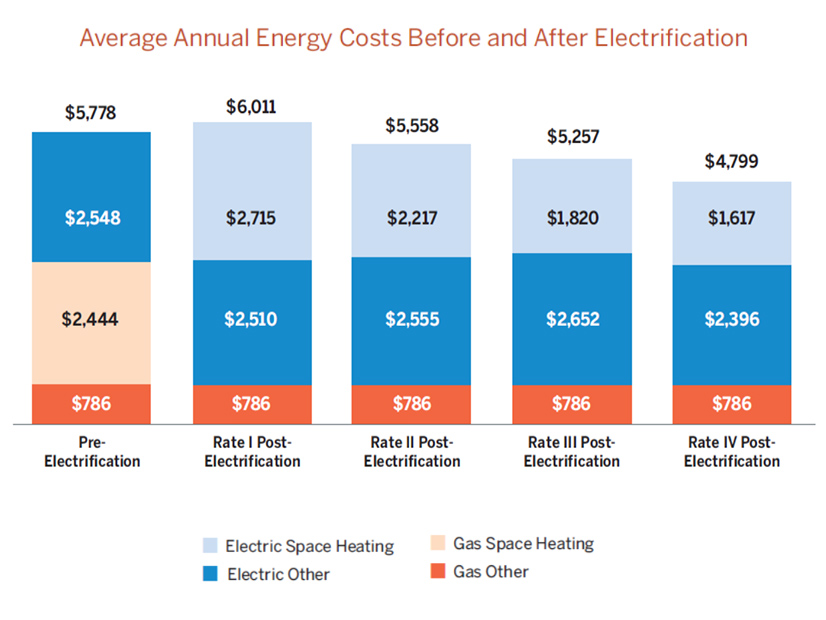Without new retail rate designs, full electrification will cause higher overall energy bills for consumers in some regions of the country, the American Council for an Energy Efficient Economy said in a report Thursday.
The success of electrification efforts, which are a major part of addressing climate change, will depend on pairing them with policies that improve equity and lower energy burdens for consumers, according to “Equity and Electrification-Driven Rate Policy Options.”
“When electric rates are high, fuel switching can increase the overall energy bill for participating customers,” the paper said. “In those circumstances, utilities should find ways to lower the operating costs of electrified appliances, especially for LMI [low- and moderate-income] households.”
Electrification involves switching major appliances that use natural gas or heating oil such as furnaces and water heaters and replacing them with devices that run on electricity such as heat pumps.
Earlier research from ACEEE has found that a quarter of U.S. households already have a high energy burden, meaning they spend more than 6% of their income on utility bills. Those bills have been going up lately because of extreme weather and the war in Ukraine.
Heat pumps are more efficient than traditional furnaces that burn fossil fuels, but in some states, electric prices are high enough to negate those savings.
“California and New England are two areas in which electricity rates are significantly above average; in the rest of the United States, electrification will often produce lower total energy bills,” ACEEE said.
Fuel switching could decrease rates, especially if the higher demand happens during times when the grid is not stressed. Other trends, such as the growing use of distributed energy resources, will reduce peak demand, also helping lower rates.
But some regions, including colder areas where electrified heating loads are going to be high, could see higher energy burdens on LMI consumers, the report said.
“It is thus critical to add new electricity demand efficiently; energy burdens could be lowered if electricity rate designs fairly allocate costs and send adequate price signals to inform and give customers opportunities to reduce system costs by changing consumption patterns at high-cost hours,” the report said.
Without the policies and rate design, the higher prices in some regions could deter consumers from switching to electricity. The paper evaluated several rate designs but said it was not attempting to provide a comprehensive list of potential solutions.
One option is percentage of income payment plans (PIPPs), which lower burdens for low-income consumers by capping utility bill payments at a set percentage of a participant’s income. They keep bills affordable regardless of increases in utility rates, so they can be a complimentary policy to any other rate designs, the paper said.
PIPPs should be coupled with longer-term investments in efficiency and weatherization for low-income homes, which would lower their demand while improving the health and safety conditions of their homes.
Another option is rate designs that enable heating electrification. Rates that offer incentives for customers to change their behavior such as time-varying rates, and ones that are tailored to the operational characteristics of major appliances like heat pumps can cut the impact of fuel switching when areas face higher rates than the national average.
Heat pumps are used most in off-peak hours, so they could benefit from time-varying rates, and they tend to have high load factors most of the time, making their electricity usage more constant and less peaky, so demand-based rights might favor them, all else being equal.
Rate Design Alternatives
ACEEE borrowed some rate designs from an Energy Systems Integration Group report, which offered three alternatives that could lower bills when consumers electrify in areas with high power prices.
One, called “Rate II” (Rate I refers to the standard rate), would have lower volumetric charges to offset higher usage with a much higher customer charge to make up for utility costs.
Rate III would have a somewhat higher customer charge and seasonal volumetric charges, as well as peak and off-peak rates. The rates would be slightly higher than the control in the summer months, but favor non-summer off-peak electricity usage while utilities recover their costs from demand during summer peaks.
Rate IV would have a higher customer charge; seasonal supply charges similar to Rate III’s, but with a less drastic cost difference; and delivery charges that are only 10% of Rate I’s charges. It would add seasonal charges for peak and off-peak periods per kilowatt of demand, with lower charges during the summer.
The introduction of a demand charge, based on consumers’ highest monthly use, could be controversial because that use might not stress the grid at all if it is not aligned with the system peak demand.
Another option to keep rates reasonable while encouraging electrification is to implement an income-based fixed charge. California is considering the approach after Gov. Gavin Newsom (D) last year signed Assembly Bill 205, which requires the state’s Public Utilities Commission to consider a rate with at least three income levels and implement the change by July 2024 while ensuring the change does not hinder electrification and greenhouse gas reductions generally. Historically, California has had very high volumetric rates that include charges for things that do not directly relate to delivering energy, such as wildfire mitigation.
The CPUC has been at work implementing the law, with the state’s three major investor-owned utilities submitting a joint plan this April, as did other stakeholders. The average fixed monthly charge for the utilities varies: It would be $53 for Pacific Gas & Electric, $74 for San Diego Gas & Electric and $49 for Southern California Edison, while other parties proposed lower fixed rates.
“Some stakeholders have asserted that higher fixed charges give customers less control over their bills and may be less equitable for customers who do not consume a lot of energy,” ACEEE said. “There are also debates over the best way to recover utility system costs through fixed charges.”

